
La caza submarina es una actividad que se inició hace más de un siglo. Los hombres, en su necesidad de buscar alimentos, recurrieron a usar técnicas y herramientas para poder cazar a especies acuáticas, tanto en el mar como en lagos o ríos.
Los pescadores submarinos para mantener viva su afición, sobre todo en épocas de frío o cuando las condiciones ambientales no son las adecuadas, se les ingenió el hacer algo parecido, pero en una piscina. De esa manera, no cazaban peces, pero sí podían usar sus fusiles y no perder la destreza, su capacidad de apnea y su puntería. Así fue que se originó el Tiro Subacuático.
Con el tiempo, se extendió esta práctica a la modalidad deportiva, y en muchos países se han realizado importantes eventos a nivel de federaciones y clubes.
¿En qué consiste?
El tiro subacuático es una modalidad deportiva que se ejecuta en una piscina, donde el atleta, en una inmersión en apnea, dispara su fusil de pesca para que la varilla impacte el centro de una diana fija.
Tras el silbato, los atletas se sumergen desde la línea de salida hasta la línea de disparo. Entre ellas suele haber una separación de hasta 15 metros.
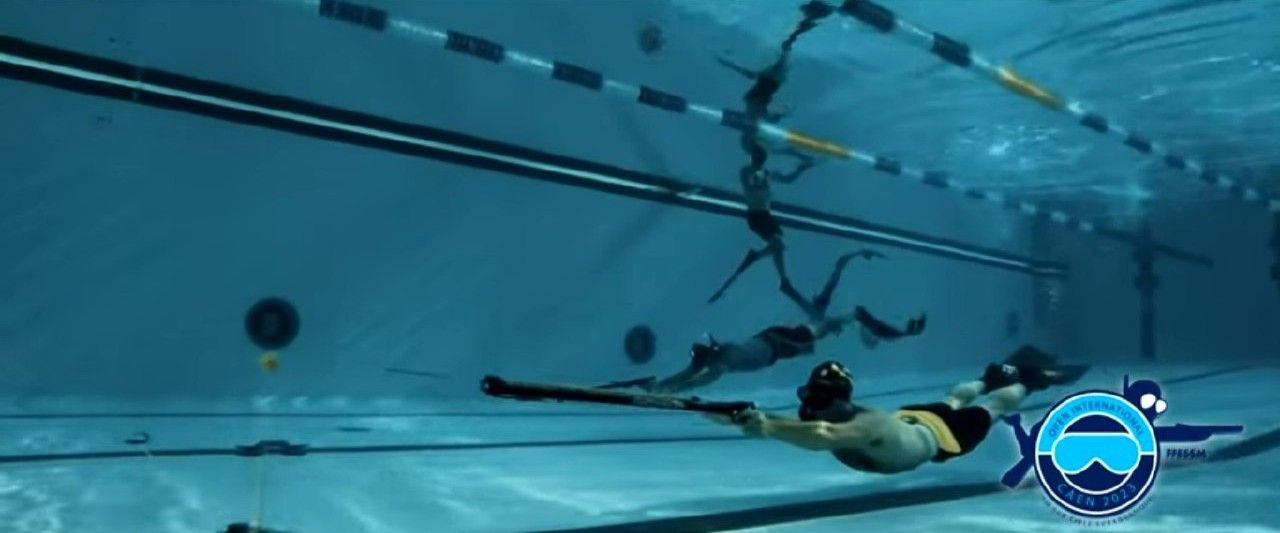
Un deporte que amerita un entrenamiento físico frecuente, para que la persona llegue a extender el tiempo de apnea, logrando el control respiratorio y psicológico.
De acuerdo con la temperatura del agua, los atletas pueden usar o no traje de neopreno. De esa forma se protegen de la hipotermia, que es una de las variables que más consumen oxígeno y energía.
El neopreno lleva a la persona a una flotabilidad positiva, por ese motivo, hay que recurrir al uso de cintos de plomo, para que el atleta pueda pegarse al fondo y tener mejor estabilidad de su cuerpo.
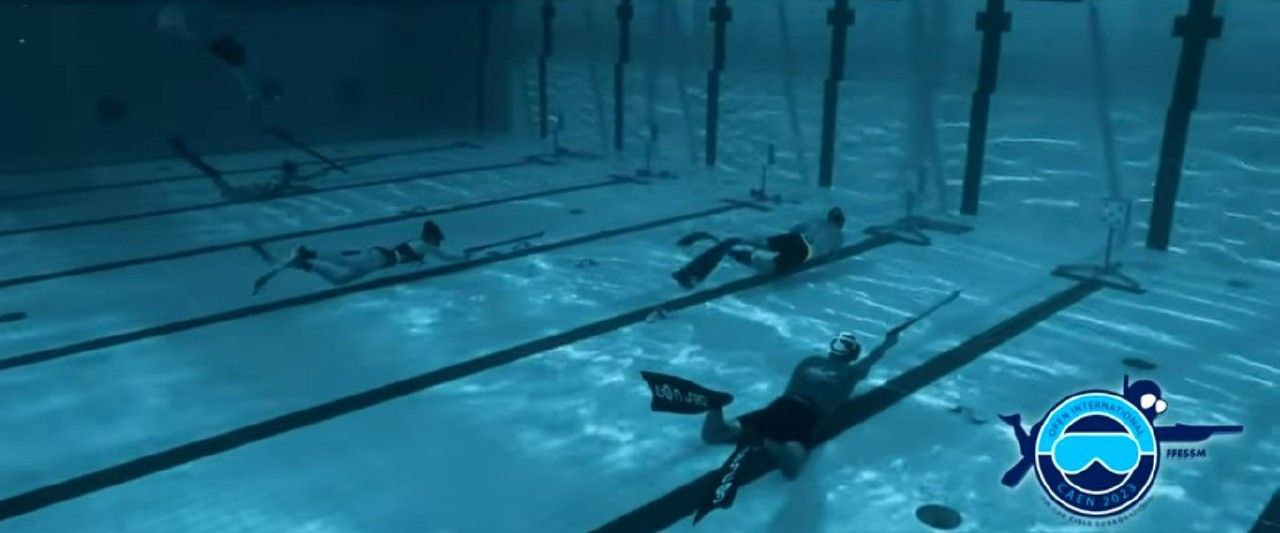
Se permiten fusiles de ligas o con aire comprimido; hechos artesanalmente o de fábrica.
Según mi experiencia, practicando pesca submarina por muchos años, un fusil de aire comprimido logra más potencia de impacto, más ruido en el disparo, pero con este se logra menos precisión respecto al fusil con ligas.
En este, la varilla queda expuesta arriba, y podemos apuntar mejor al blanco para lograr el resultado que esperamos.
Se usa un dispositivo plástico donde vemos 5 dianas, separadas del piso de la piscina por soportes.
El competidor, al descender, debe cargar su fusil y disparar en un tiempo establecido. Si no lo hace, debe descargarlo antes de subir a superficie.
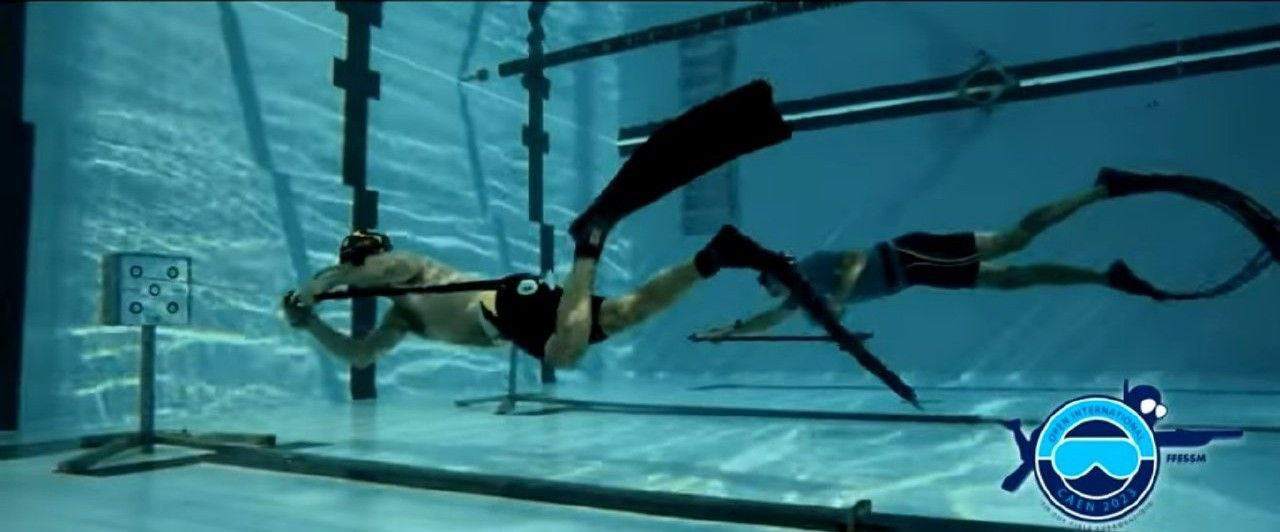
El tiro se hace con una mano, y con la otra, se agarran del soporte que se ubica en el fondo. El deportista puede apoyarse en el fondo buscando sentirse estable. El fusil no puede tocar el fondo, ni apoyarse en el soporte.
El cuerpo del atleta y el fusil no deben sobrepasar la línea de disparo. Después de disparar, debe salir a superficie portando la varilla.
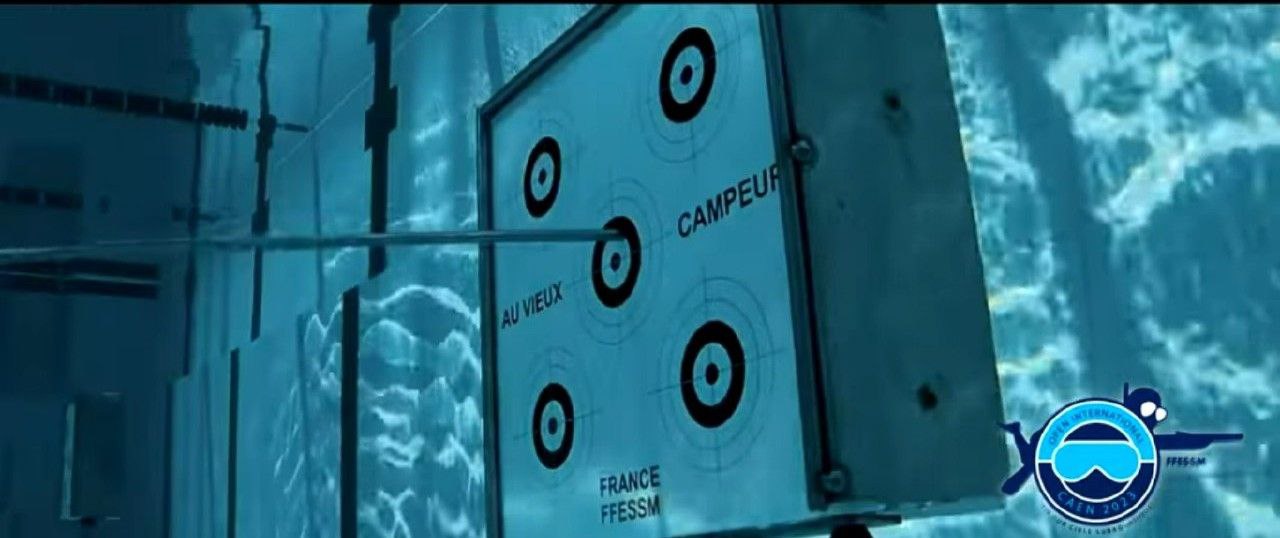
¿Cuáles son sus modalidades?
- Tiro de precisión:
Se dispara a una distancia de 3 metros. Se permiten 10 tiros en 10 minutos y dos disparos por diana.
- Biatlón:
Aquí se realizan 5 tiros. Previamente, el atleta se desplaza 5 metros sin pasar de los 2.5 minutos de tiempo.
Tanto en el Tiro de Precisión, como en el Biatlón, se compite en equipos por géneros.
- Equipos:
La integran 2 atletas por equipo, hombre y mujer, con tiempo delimitado a 5 disparos.
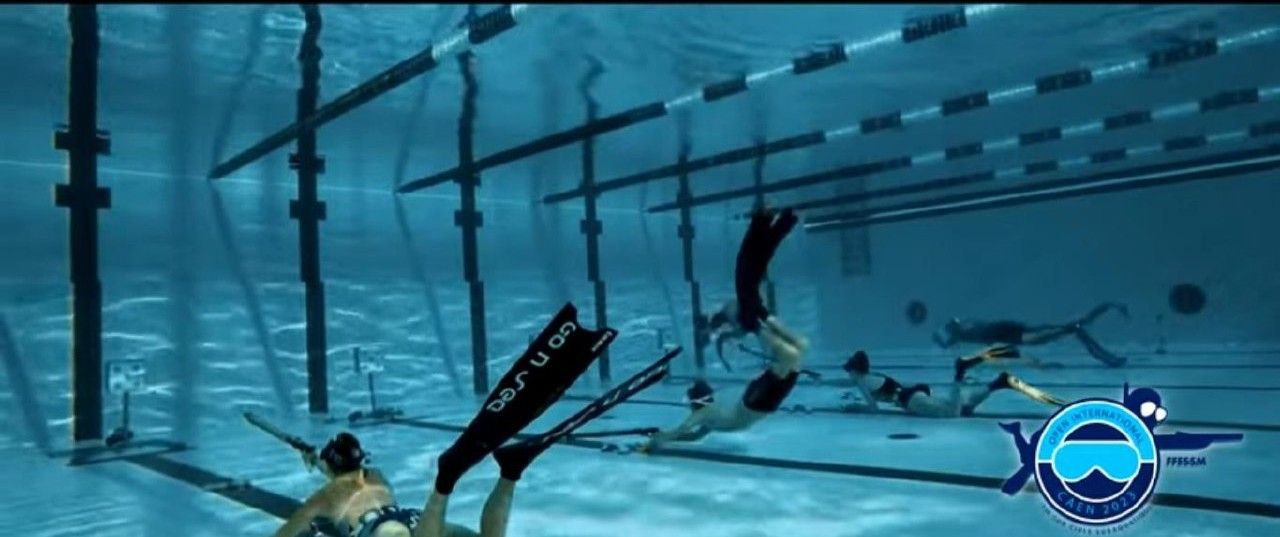
Como pueden ver en la imagen superior, en la piscina se pueden ubicar hasta 5 soportes con sus dianas, justo en la zona de la raya oscura. Así logran guiarse mejor y tomar cierta distancia entre cada competidor.
Es oportuno, que el agua esté limpia para que mantenga buena transparencia. Aquí no puede haber error y el fusil jamás se puede cargar en superficie.
Hay que tener madurez mental y disciplina, para seguir las reglas, y no causar un disparo descontrolado que pueda lesionar a otra persona.
Por ello, es un deporte donde la edad mínima permitida es a partir de los 17 años.
Válido a toda actividad de buceo, estos deportistas también necesitan estar entrenados, recibir un control de salud anual, y previo a la competición, la valoración de pre inmersión por un team médico.
Aunque ellos disparen sus fusiles y no precisamente a una presa, se someten a ciertos riesgos, los que ya conocen de mis otros posts. Lo más adecuando, será una actualización de conocimientos, para que puedan prevenir cualquier tipo de accidente en medio acuático.
Gracias a los que me leyeron. Les deseo un bonito inicio de semana.
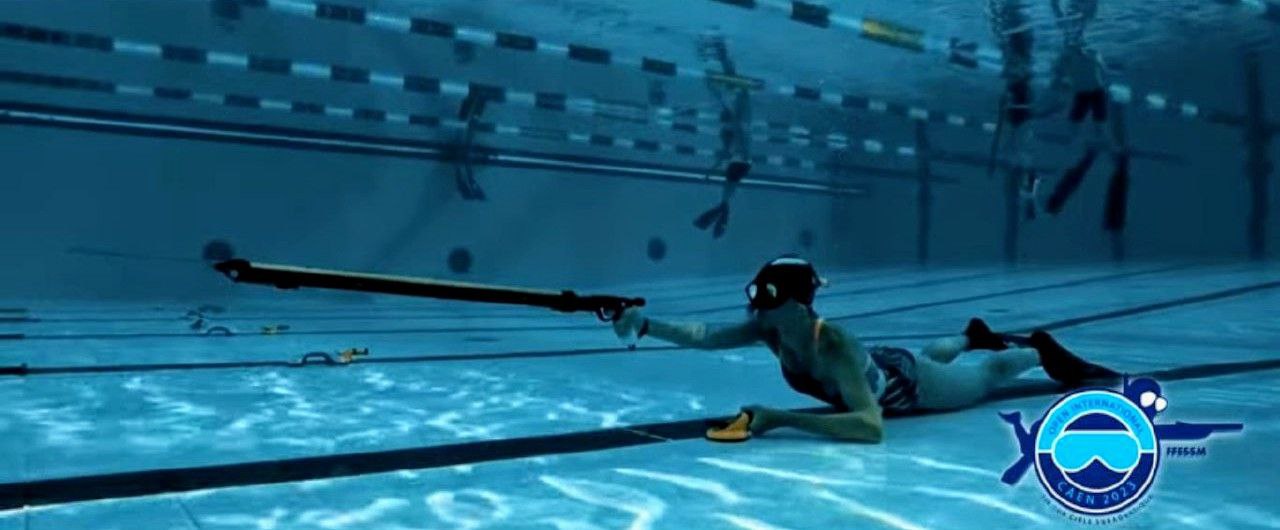
Underwater Shooting: a sport that does not kill fish

The spearfishing is an activity that began more than a century ago. Men, in their need to find food, resorted to using techniques and tools to hunt aquatic species, both in the sea and in lakes or rivers.
In order to keep their hobby alive, especially in cold weather or when the environmental conditions are not suitable, spearfishermen have managed to do something similar, but in a swimming pool. That way, they did not hunt fish, but they could use their spearguns and not lose their dexterity, their apnea capacity and their aim. This was the origin of Underwater Target Shooting.
Over time, this practice was extended to the sporting modality, and in many countries important events have been held at the level of federations and clubs.
What does it consist of?
Underwater shooting is a sport that takes place in a swimming pool, where the athlete, in an apnea immersion, shoots his speargun so that the shaft hits the center of a fixed target.
After the whistle, the athletes dive from the starting line to the firing line. There is usually a separation of up to 15 meters between them.

A sport that requires frequent physical training, so that the person can extend the freediving time, achieving respiratory and psychological control.
According to the water temperature, athletes may or may not wear a wetsuit. This way they protect themselves from hypothermia, which is one of the most oxygen and energy consuming variables.
The neoprene leads the person to a positive buoyancy, for this reason, it is necessary to resort to the use of lead belts, so that the athlete can stick to the bottom and have better stability of his body.

Rubber bands or pneumatic speargun are allowed, whether handmade or factory-made.
In my experience, practicing spearfishing for many years, a pneumatic achieves more impact power, more noise in the shot, but achieves less precision compared to a speargun with rubber bands.
In this one, the shaft is exposed at the top, and we can aim better at the target to achieve the result we expect.
A plastic device is used where we see 5 targets, separated from the pool floor by supports.
The competitor, when descending, must load his speargun and shoot within a set time. If he does't, he must unload it before ascending to the surface.

The shot is made with one hand, and with the other hand, they hold on to the support that is located at the bottom. The athlete can lean on the bottom to feel stable. The speargun may not touch the bottom, nor lean on the support.
The athlete's body and the speargun must not exceed the firing line. After shooting, the athlete must come to the surface carrying the shaft.

What are its modalities?
- Precision shooting:
Shot at a distance of 3 meters. Ten shots are allowed in 10 minutes and two shots per target.
- Biathlon:
Here 5 shots are fired. Previously, the athlete moves 5 meters without exceeding 2.5 minutes of time.
In both the Precision Shooting, as in the Biathlon, it is competed in teams by gender.
- Teams:
It is integrated by 2 athletes per team, male and female, with time delimited to 5 shots.

As you can see in the image above, up to 5 supports with their targets can be placed in the pool, just in the area of the dark stripe. This way they can be guided better and take some distance between each competitor.
It is advisable that the water is clean so that it maintains good transparency. There can be no mistakes here and the speargun can never be loaded on the surface.
It is necessary to have mental maturity and discipline, to follow the rules, and not to cause an uncontrolled shot that can injure another person.
Therefore, it is a sport where the minimum age allowed is from 17 years old.
Valid to any diving activity, these athletes also need to be trained, receive an annual health check-up, and prior to the competition, a pre-dive evaluation by a medical team.
Although they shoot their spearguns and not exactly at a prey, they are subjected to certain risks, which you already know from my other posts. The most appropriate thing to do is to update their knowledge, so that they can prevent any type of accident in the aquatic environment.
Thanks to those who read me. I wish you a nice start of the week.


Separador. De uso libre por/Text divider. Free use from @eve66
Fotos: Capturas de pantalla de video de Sportalsub en YouTube/Photos: Screenshots from Sportalsub video on YouTube
Edición/Edition: Photoshop
Texto por/Text by Andrés Brunet
Gracias por leer/Thank you for reading
Bienvenidos sus comentarios/Welcome your comments
¡Saludos infinitos!/Infinite greetings!
